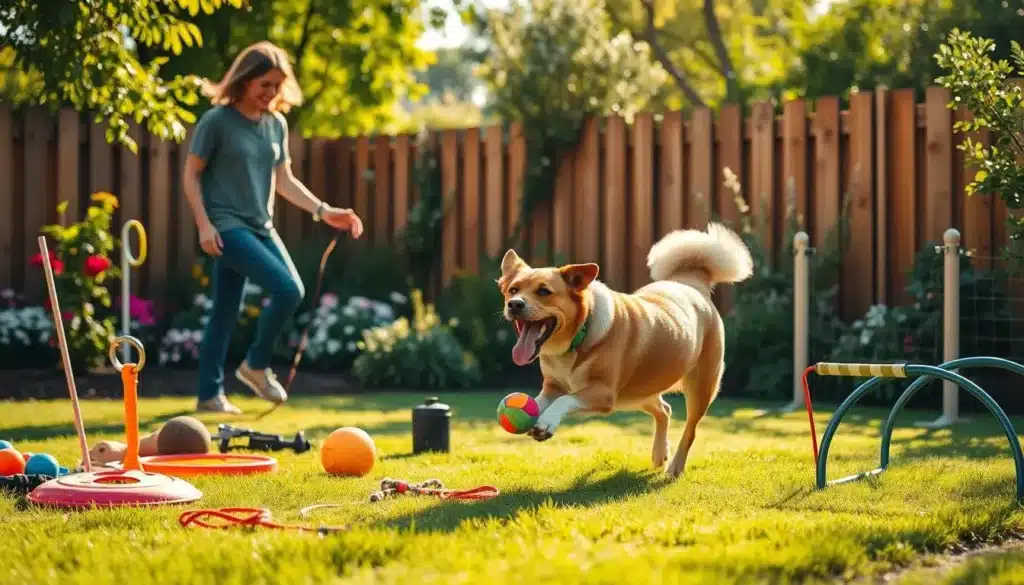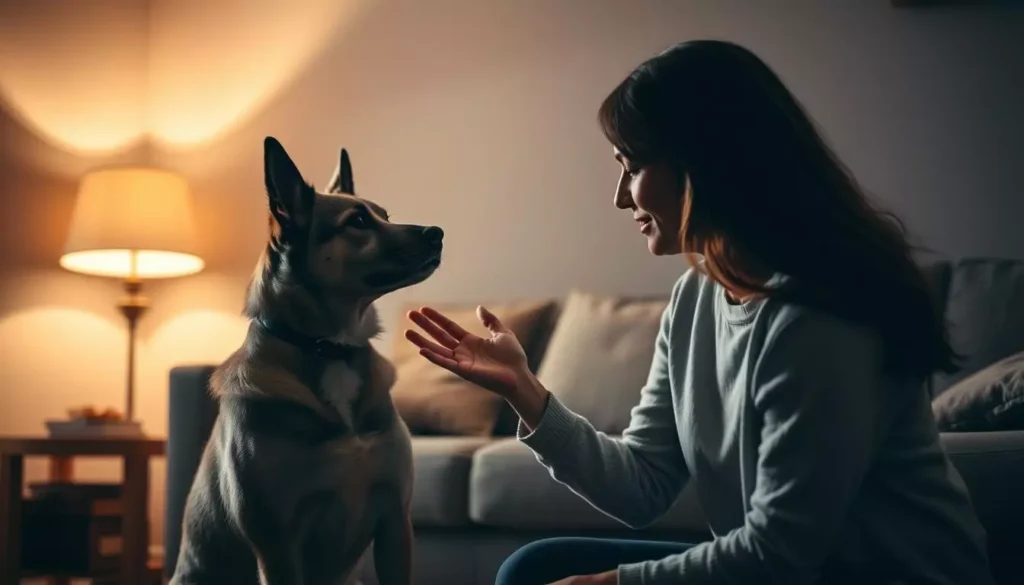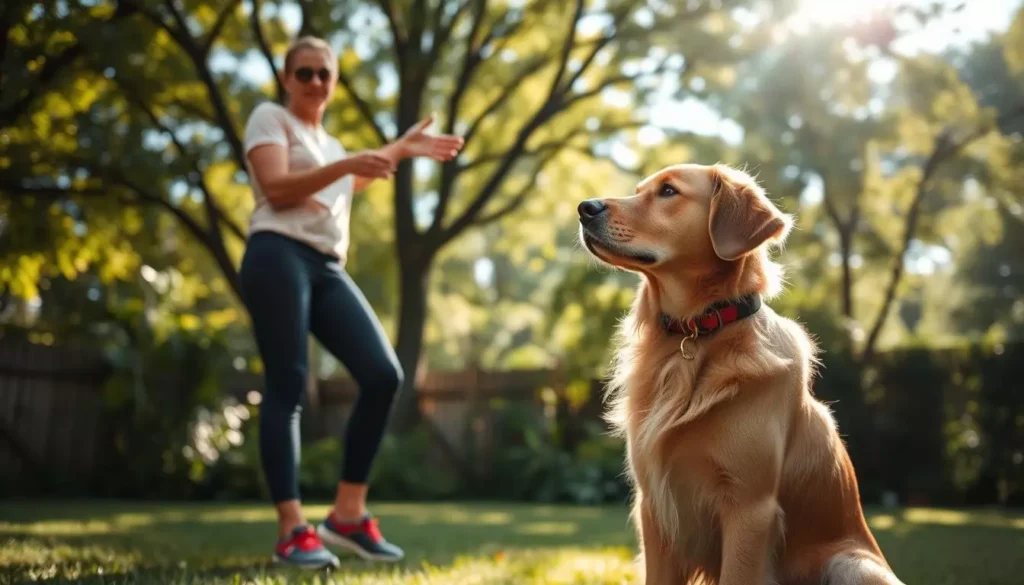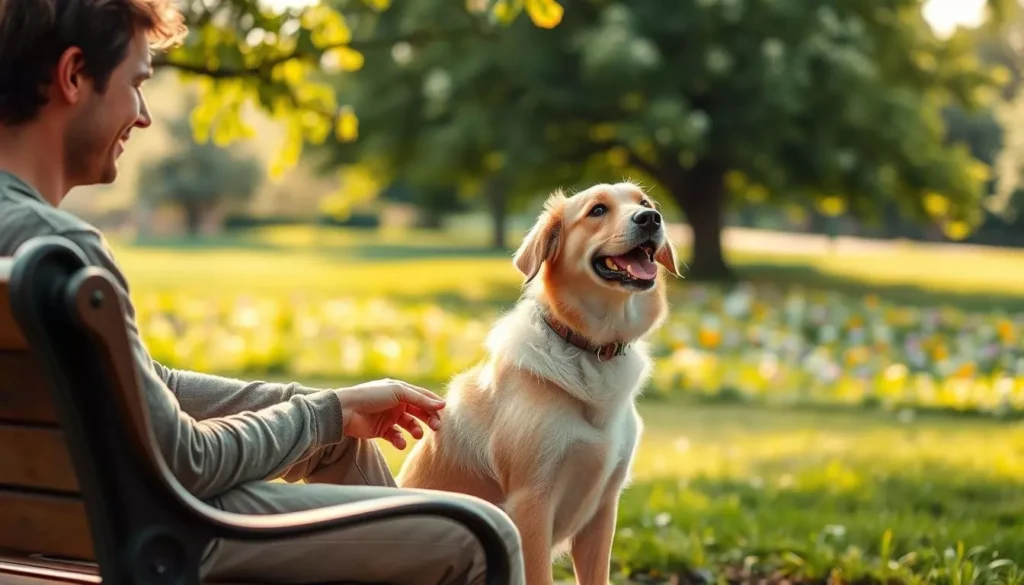Have you ever wished for peace in your home, only to have your dog bark? I've been there too. It's tiring and upsetting when your dog barks at every noise. But, with patience and effort, you can teach your dog to bark less.
It's important to remember that dogs bark naturally. They use it to communicate. So, we can't expect them to be completely silent. But, we can find ways to reduce the noise. This guide will help you learn how to do that.
Whether you want to stop your dog from barking when you're away or when they're excited, we've got you covered. We'll explore effective methods to make your home a peaceful place for both you and your dog.
Key Takeaways
- Understanding the reasons behind barking is the first step in training.
- Methods exist to reduce barking without eliminating it entirely.
- Patience and consistency are crucial in your training approach.
- Recognizing when your dog barks can help tailor more effective solutions.
- Identifying visual stimuli can aid in minimizing unnecessary barking.
- Using commands and placing your dog can provide better control over barking situations.
Understanding Why Dogs Bark
Barking is a key way dogs communicate. It shows their feelings and needs. Some reasons dogs bark include alerting owners to dangers, showing frustration, or wanting attention. I often wonder, why does my dog bark? Knowing why helps me train them better.
Dogs bark for different reasons in different situations:
- Territorial barking: Dogs bark when they feel their space is threatened.
- Alarm barking: They bark to warn owners of something unusual.
- Frustration barking: Dogs bark when they can't get something they want.
- Attention-seeking barking: They bark to get their owner's attention.
Knowing what motivates my dog's barking helps me respond. Barking is natural, but too much can be a problem. It usually means my dog needs something, and I can help with training.
Common Reasons for Excessive Barking
When I think about why dogs bark too much, a few things come to mind. Boredom is a big one. Dogs left alone for too long might bark to show they're upset. This can lead to bad habits.
Anxiety is another big reason. Dogs with separation anxiety bark when they're left alone. They're showing they're scared. Some dogs also bark at sounds or movements outside. Knowing why they bark is key for owners.
Excitement can also make dogs bark a lot. They might bark during play or when they see something exciting outside. This shows they want attention. To stop a puppy from barking at night, we need to understand these reasons.
By understanding why dogs bark too much, we can find ways to help them. Dog barking at night usually comes from these reasons. Recognizing them helps us find solutions that make our bond stronger.

Recognizing the Type of Barking
Knowing the types of dog barking is key for dog owners. Each bark has its own reason, and knowing these can help us fix our dog's behavior. For example, when my dog barks at TV animals, it's usually because he's excited or worried.
This happens when something on TV catches his attention. It's like his instinct is telling him to react.
To tackle the barking, we need to sort it out. Here are some common types:
| Type of Barking | Description | Common Triggers |
|---|---|---|
| Alert Barking | Occurs when a dog senses something unusual. | Strangers approaching, noises. |
| Playful Barking | A cheerful bark during playtime. | Playing with toys, interacting with other dogs. |
| Lonely Barking | Happens when a dog feels isolated. | Owner leaving the home, dog left alone for long periods. |
| Anxious Barking | Indicates fear or stress, possibly from noise. | Thunderstorms, loud noises, perceived threats. |
| Frustration Barking | Complaints when they want to go outside or to play. | Seeing another dog outside, wanting attention. |
By figuring out the types of dog barking, I can make a better training plan. This plan is based on what my dog reacts to, like TV animals. Knowing these patterns helps us manage their behavior better. It makes our home a happier place for both of us.
Training Dog Not Barking: Initial Steps
Starting to train my dog to stop barking when I leave is a big step. First, I figure out what makes them bark a lot. I watch my dog closely to see what sounds or sights make them bark. For instance, a delivery truck might make them bark a lot.
It's important to know why my dog barks. Often, it's because they're anxious or bored when alone. Knowing this helps me come up with the right plan to stop the barking. I make strategies that fit these reasons, which helps a lot in training.
| Trigger Type | Example | Possible Cause |
|---|---|---|
| Sound | Doorbell ringing | Alerting or excitement |
| Sight | Passing cars | Curiosity or territorial behavior |
| Separation | Owner leaving the house | Separation anxiety |
| Loneliness | Empty room | Boredom and lack of engagement |
With this knowledge, I'm ready to train my dog better. Watching closely and taking action helps a lot in reducing barking.

Desensitization Techniques for Dogs
Desensitization techniques help my dog get used to things that make them bark. I start by exposing them to the things that make them bark in small steps. For example, if they bark at cars, I begin by standing far away.
As they get more comfortable, I slowly move closer. This helps them learn to handle their excitement or fear without barking.
When my dog stays quiet, I reward them with treats or praise. This teaches them that being quiet is good. Doing this often helps them learn faster.
The main goal is to teach my dog to handle their reactions better. By rewarding them for staying calm, I help them react less to triggers. Being patient and understanding makes this process work well for both of us.
Using Commands Effectively
Effective communication is key in dog training, especially for barking issues. Using clear commands like “quiet” sets clear expectations. This method reduces confusion and strengthens our bond. It's important to be consistent with these commands.
When my dog barks out of turn, I use the same command. This lets them know it's time to stop. Consistency is crucial.
Using rewards with commands makes training better. When my dog is quiet, I praise or give them a treat. This positive feedback helps them learn to stop barking on command. Short, fun training sessions help avoid frustration and boost learning.
Practicing commands in different places is also helpful. It prepares my dog for distracting situations. I introduce challenges that might make them bark, but I stay calm and confident. This shows them I'm in charge.

Removing Visual Stimuli to Reduce Barking
One way to cut down on barking is to reduce what your dog sees. Simple steps can make a big difference. For example, closing blinds or curtains blocks your dog's view of squirrels or people walking by.
These sights often make your dog bark, disrupting your home. It's a common problem many dog owners face.
Using white noise machines is also helpful. They create a background sound that covers up other noises. This makes your home quieter, especially when your dog gets excited by TV scenes.
By using these methods, you can help make your home a calmer place. It's all about creating a peaceful environment for both you and your dog.
Implementing Place Training for Control
Place training for dogs is a great way to cut down on barking. It sets up a special area where your dog feels safe and calm. When I say “place,” my dog knows it's time to chill, especially when things get loud or scary.
By teaching my dog to stay in this spot, I help them learn to be calm. This is true whether friends come over or a delivery person knocks on the door. My dog learns to relax instead of getting excited. This training makes them feel safe and teaches them important boundaries.
Alleviating Boredom to Prevent Barking
Boredom can make dogs bark too much. It's key to give them enough exercise and mental games. Daily walks, fetch, and games are great for burning off their energy. These activities help keep them from getting bored and bark less.
Interactive dog toys add fun to playtime. Puzzles challenge dogs to think and solve problems. I change these toys often to keep my dog curious and less likely to bark.
| Activity Type | Benefits | Examples |
|---|---|---|
| Physical Exercise | Burns energy and improves fitness | Walks, runs, fetch |
| Mental Stimulation | Enhances problem-solving skills and focus | Puzzle toys, training games |
| Social Interaction | Increases happiness and reduces anxiety | Playdates, dog parks |
By focusing on these activities, I manage my dog's boredom. This makes our home quieter and happier. Exercise and fun toys create a win-win situation for both of us.
Anti-Stress Devices for Barking Issues
Dealing with barking issues can be tough. But, anti-stress devices often help with dog anxiety. Pheromone collars are a popular choice. They release calming scents that mimic what nursing dogs produce, soothing anxious pets.
Anxiety wraps or jackets are another good option. They apply gentle pressure, which comforts dogs. Using these devices has greatly reduced my dog's stress and barking.
| Device Type | Description | Effectiveness |
|---|---|---|
| Pheromone Collars | Emit calming scents to help relieve anxiety | High |
| Anxiety Wraps | Apply gentle pressure for comfort | Moderate to High |
| Calming Sprays | Using soothing fragrances for immediate relief | Moderate |
Using anti-stress collars and other calming devices can really help. I suggest trying different ones to find what works best for your dog.
Using a Dog Bark Spray Collar as a Solution
A dog bark spray collar is a useful tool for managing excessive barking. It uses a harmless citronella spray that goes off when a dog barks. This method works by interrupting the dog's barking, making them associate it with an unpleasant feeling.
With time, dogs get used to the spray collar. They start to bark less, which makes pet parents happier. Unlike treats, which don't work for all dogs, the spray collar corrects barking right away.
Using the collar regularly makes it more effective. Keep an eye on how your dog reacts to it. Remember, every dog is different, so adjust the collar to fit their needs for the best results.
When to Hire a Professional Dog Trainer
Not every barking issue can be solved by training at home. When my home efforts fail, I think about getting a professional dog trainer. They have lots of experience and can create plans just for my dog's needs and personality.
A professional dog trainer can do more than teach basic commands. They also offer ongoing support to keep my dog's good behavior going. They might even find out why my dog barks too much.
When I'm stuck or unsure, a professional trainer can really help. Getting dog training services brings new ideas and a clear plan to solve problems. It also helps me and my pet get closer.
Challenges of Barking and Troubleshooting
Every dog owner faces different challenges with their dog's barking. These problems can grow due to stress, changes in the environment, or new family members. I've had my own struggles with my dog's barking habits. It's important to understand these challenges to solve barking problems effectively.
Keeping training consistent is a big challenge. Dogs like routine, and any changes can confuse them and make them bark more. It's also hard when many things make them bark. Finding and fixing each cause takes time and effort.
Working with my family was crucial in solving these issues. We all needed to agree on commands and how to correct barking. This unity helps avoid mixed messages that can make barking worse.
| Challenges | Potential Solutions |
|---|---|
| Inconsistent training | Establish a routine and ensure everyone is informed |
| Multiple barking triggers | Identify each trigger and develop targeted strategies |
| Lack of patience | Set realistic expectations and track progress |
| Different family responses | Discuss and agree on responses among family members |
My journey to address my dog's barking has taught me a lot. Every step forward makes our home calmer and strengthens our bond.
Conclusion
Dog barking is complex and vital to understand. While it's natural, too much can upset our homes. Using techniques like desensitization and place training helps a lot.
Creating a detailed plan is key. This includes using commands and removing things that make dogs bark. It makes our lives with dogs better and more enjoyable for everyone around us.
Changing a dog's barking habits takes time and effort. But with the right approach, we can make our homes and public spaces quieter. This makes our lives together happier and more peaceful.




